|
 |
 |
 |
These days, rarely do you hear about a game made by one man. A vast majority of gaming software requires dozens of people's involvement - that is, if the developer wants the game to be released in a remotely reasonable amount of time. While not exactly classifiable as a "video game," Electroplankton was indeed conceived by one man, at least for the greater part of the software's development.
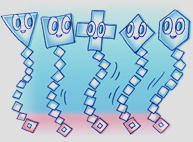
Toshio Iwai, a renowned Japanese artist in multiple senses of the word, is responsible for Electroplankton, perhaps the most unique piece of software to grace the gaming industry in years. Not only did he come up with the ideas for Electroplankton, Iwai had just enough programming knowledge to write some code for the game, a rarity in artists. Of course, the whole of Electroplankton was not completed by this one man, as a total of fifteen people, including executive producer and president of Nintendo Satoru Iwata, had a part in the creation of Electroplankton. But don't be fooled - the small development team does not make for shoddy software. In fact, despite the low amount of content in Electroplankton, the art, sound, control, and most importantly, the ideas, are of high quality, despite their simplicity.
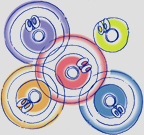 The best way to describe Electroplankton is as an interactive and improvisational visual audio tool. It's quite a mouthful, and definitely not a genre in which many games are spawned. There is absolutely no goal in Electroplankton, which definitely makes it difficult for anyone to refer to it as a game. However, for the lack of a better yet equally simple term, only for this review will I be referring to Iwai's creation as a "game." Players looking for a challenge won't find any in Electroplankton, as the game is merely there to be tinkered with, and not beaten in any way. The best way to describe Electroplankton is as an interactive and improvisational visual audio tool. It's quite a mouthful, and definitely not a genre in which many games are spawned. There is absolutely no goal in Electroplankton, which definitely makes it difficult for anyone to refer to it as a game. However, for the lack of a better yet equally simple term, only for this review will I be referring to Iwai's creation as a "game." Players looking for a challenge won't find any in Electroplankton, as the game is merely there to be tinkered with, and not beaten in any way.
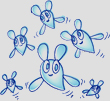 While there is no goal, or levels, or playable characters, or any sort of element that you'd find in a conventional video game, what Electroplankton does offer is interaction with on-screen visuals that emote sound. The connection between the player and the audio comes in the form of plankton, microscopic aquatic creatures that beg to be touched, blown at or talked to. For example, a player can touch a plankton, a simple creature seen on-screen, which would in turn make a sound of its own. Now, say there are many plankton, located at different areas on-screen. The player could then touch multiple plankton, each of which would emit a different note or pitch of sound depending on their position on-screen. This is how the visual aspect of the game, represented by the different plankton, is directly related to the audio that is created as the player interacts with the creatures. While there is no goal, or levels, or playable characters, or any sort of element that you'd find in a conventional video game, what Electroplankton does offer is interaction with on-screen visuals that emote sound. The connection between the player and the audio comes in the form of plankton, microscopic aquatic creatures that beg to be touched, blown at or talked to. For example, a player can touch a plankton, a simple creature seen on-screen, which would in turn make a sound of its own. Now, say there are many plankton, located at different areas on-screen. The player could then touch multiple plankton, each of which would emit a different note or pitch of sound depending on their position on-screen. This is how the visual aspect of the game, represented by the different plankton, is directly related to the audio that is created as the player interacts with the creatures.
Two modes separate the game: Performance mode, in which players interact with the plankton themselves, and Audience mode, where pre-set programming by the developers allows players to just listen as the game plays itself. There are ten different plankton with which to interact.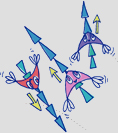 Each of them has their own, unique way of producing sound. One of them, for example, conveniently named Tracy, follows a path that players trace with the stylus, making a different pitch of sound at every angle on which it travels. Another, a personal favourite in Hanenbow, is launched from a leaf towards other leaves that can be rotated by the player, and makes a different sound at every instance the Hanenbow makes contact with a leaf. Yet another, Volvoice, uses the Nintendo DS's microphone capability to accept a few seconds' worth of the player's voice, or any other recording, only to alter and re-play the recording in truly odd ways. Each of them has their own, unique way of producing sound. One of them, for example, conveniently named Tracy, follows a path that players trace with the stylus, making a different pitch of sound at every angle on which it travels. Another, a personal favourite in Hanenbow, is launched from a leaf towards other leaves that can be rotated by the player, and makes a different sound at every instance the Hanenbow makes contact with a leaf. Yet another, Volvoice, uses the Nintendo DS's microphone capability to accept a few seconds' worth of the player's voice, or any other recording, only to alter and re-play the recording in truly odd ways.
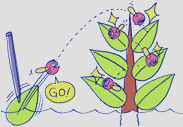
While the different plankton do offer a nice variety of sounds and possibilities, for the most part it isn't at all easy to compose coherent music. What you'll hear most of the time is an outburst, a mess of different musical notes and sounds that can either, perhaps by luck, sound nice and soothing to the ear, or just come out unnerving and annoying. While you do have control over what's happening, it is very difficult to learn to control the plankton in a way for them to make beautiful music. But here's a catch: even if you do manage to get the plankton to make nice music for you, whether by luck  or intention, you won't be able to record it to save it for a later listen. The game does not feature any memory saving, meaning all your music and sounds are made to be listened to live and on-the-spot, a disappointing yet likely intended shortcoming. or intention, you won't be able to record it to save it for a later listen. The game does not feature any memory saving, meaning all your music and sounds are made to be listened to live and on-the-spot, a disappointing yet likely intended shortcoming.
Although it is difficult to make pleasing sounds, some players will just not be able to help mucking about with the plankton for hours on end. It's true that some players will blaze through the ten plankton in half an hour before calling it quits, but others will definitely be intrigued by interacting with and discovering some of - if not all - the creatures' secrets for hours upon hours. The secrets of Eletroplankton aren't all easy to uncover, unless of course you read Japanese and take a look at the intricate manual.

 The sound quality is excellent. The DS's stereo output is used effectively and almost emulates surround sound if it's listened to via headphones. There's a great variety of different sounds used, covering all sorts of different instruments - from piano to drums to old-school gaming blips and bleeps. There are even some pre-recorded beats and melodies, such as that of the classic Starman item from the Super Mario Bros. series, to which players add their own sounds using one of the plankton species. The sound quality is excellent. The DS's stereo output is used effectively and almost emulates surround sound if it's listened to via headphones. There's a great variety of different sounds used, covering all sorts of different instruments - from piano to drums to old-school gaming blips and bleeps. There are even some pre-recorded beats and melodies, such as that of the classic Starman item from the Super Mario Bros. series, to which players add their own sounds using one of the plankton species.
 The visuals are very simple, yet a treat to look at. The background is, more often than not, represented as a static color or a gradient, while the colourful and interestingly-designed plankton creatures decorate the foreground, dancing across the dual screens. The overall look of the game is pleasing to the eye and doesn't come off as tacky, despite its simultaneous use of many colours.
The visuals are very simple, yet a treat to look at. The background is, more often than not, represented as a static color or a gradient, while the colourful and interestingly-designed plankton creatures decorate the foreground, dancing across the dual screens. The overall look of the game is pleasing to the eye and doesn't come off as tacky, despite its simultaneous use of many colours.
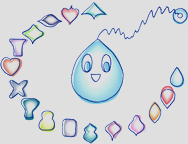
Electroplankton is a good, unique experience on the Nintendo DS, and a reasonable excuse to take a break from your regular heap of games across all other gaming systems. Its unique style, sense of interactivity and its brilliant blend of the visual and the aural is truly what defines this "game," and why it should be discovered by people abroad. There might not be a goal and it might not offer too much as far as content is concerned, but the experience alone makes it worth playing, especially if you happen to be musically inclined.
It truly is a love or hate game - some players will see brilliance in Iwai's creation, while others will merely brush it off as a useless piece of software, and neither parties would be wrong. It is a music tool that is, at the very least, intriguing to mess around with. The problem here is that this level of intrigue may or may not be enough for some gamers.
8.2
|
|
 |
 |
|
|
 |
 |
 |
Editor Comments
It was a joy opening up the sleek blue Electroplankton package that one spring day, just as it was discovering the secrets of this wonderful little audio game. It's a tool that helps define what the Nintendo DS is about - unique experiences that simply cannot be found anywhere else. It would make for an ideal pack-in with the Nintendo DS hardware.
That said, the game isn't without its flaws, and while the following aren't the reasons for the imperfect score given to the game, I was personally disappointed at the lack of one feature in particular. It would have been nice if the developers had included a mode in which players can mix the sounds of the different plankton. Combining multiple layers of different plankton sounds into one piece could've yielded interesting results - but alas, the planktons have to settle for making music with only their own breed.

Some of you may remember Electroplankton being a focus at Nintendo's E3 conference. Perhaps you even remember the DJ presentation. Having played Elecroplankton extensively before watching the DJ jam with the game during the conference, I was in disbelief at how misleading Nintendo represented Iwai's creation to the public. No, you will not be able to do what the DJ did with Electroplankton, unless you have the proper PC hardware and software, multiple Nintendo DS systems, and/or the right DJ equipment. What the DJ did at the conference is simply impossible to do in the actual game, which is a shame considering Nintendo showed us the level of potential behind Elecroplankton - a level which the actual software unfortunately falls short of.
Is Electroplankton worth the import? If you're looking to try something new and different, then yes it is worth it, but only if it isn't coming to your region. With the recently-announced North American release date of January 9th, 2006, I would recommend to people in the US and Canada to wait for the domestic release, despite the need to order it online what with its alledged "limited release." Either way, people everywhere need to discover Electroplankton and see whether Iwai's latest in software is for them: it really is worth a shot.

|
|
 |
 |
|
|
|
 |
 |
 |
 |
// A mysterious character within the Banjo-Kazooie series was meant to star in his own N64 spin-off...
Click for more . . .
|
|
 |
 |
|
|
 |
 |
 |
 |
// Delve into the philosophical world of gaming in this Pikmin 2 special, Buried Treasures
Check it out . . .
|
|
 |
 |
|
|
 |
 |
 |
[an error occurred while processing this directive]
|
 |
 |
|
|
|























